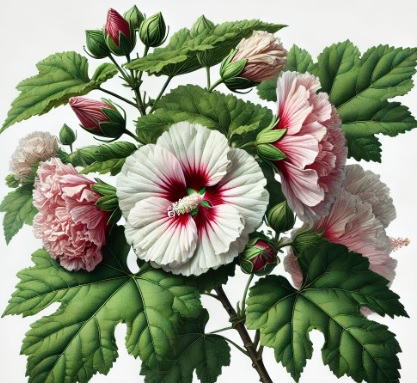Confederate Rose (Hibiscus mutabilis), commonly known as the Cotton Rose, is a striking tropical plant known for its showy flowers and robust growth. This plant is celebrated for its unique flowering pattern, where the blooms change color as they mature, creating a dynamic display in gardens and landscapes.
Botanical Classification:
Family: Malvaceae
Genus: Hibiscus
Species: H. mutabilis
Common Names: Confederate Rose, Cotton Rose
Plant Characteristics:
Size: Hibiscus mutabilis typically grows to a height of 2 to 4 meters (6 to 13 feet) with a similar spread. It has a bushy, upright growth habit, making it suitable for use as a backdrop or hedge in gardens.
Leaves: The leaves are large, lobed, and dark green with a slightly glossy texture. They are arranged alternately along the stems and contribute to the plant's lush appearance.
Flowers: The plant is renowned for its large, showy flowers that can be up to 15 cm (6 inches) in diameter. The blooms start as white or pale pink and gradually change to darker pink or red as they mature. This color transformation occurs within a single day, adding a dynamic visual element to the plant.
Fruit: Hibiscus mutabilis produces small, round capsules containing seeds. These capsules mature over time and are not typically used for ornamental purposes.
Chemical Composition and Structure:
The plant contains several beneficial compounds:
Flavonoids: Including quercetin and kaempferol, which offer antioxidant and anti-inflammatory properties.
Tannins: Present in the leaves, contributing to astringent and antimicrobial effects.
Essential Oils: Found in small amounts, providing a subtle aromatic quality.
Polysaccharides: Present in the mucilage, which can offer hydrating and soothing effects.
Uses and Benefits:
Ornamental: Hibiscus mutabilis is primarily grown for its dramatic and colorful flowers, which make it a popular choice for ornamental use in gardens and landscapes. Its ability to provide a changing display of colors adds visual interest.
Landscaping: The plant’s bushy habit and attractive blooms make it suitable for use as a focal point, hedge, or backdrop in garden design.
Cultural Uses: In some regions, Hibiscus mutabilis is used in traditional crafts and decorations due to its striking flowers.
Applications:
Landscaping: Ideal for garden beds, hedges, and as a specimen plant. It adds vibrant color and visual interest with its changing flowers.
Ornamental: Used to create focal points in gardens or to enhance the aesthetics of outdoor spaces with its large, colorful blooms.
Environmental and Safety Considerations:
Environmental Impact: Hibiscus mutabilis is well-suited to tropical and subtropical climates. It is relatively low-maintenance and can adapt to various soil types, making it a versatile choice for garden use.
Safety: Generally considered safe for ornamental use. The plant is not known to be toxic, but as with any plant, it is advisable to monitor for allergic reactions, especially when handling or using parts of the plant. There are no significant safety concerns associated with Hibiscus mutabilis.
INCI:
Antimicrobial agent. This ingredient is able to suppress or inhibit the growth and replication of a broad spectrum of microorganisms such as bacteria, fungi and viruses by making the stratum corneum temporarily bactericidal and fungicidal.
Antioxidant agent. Ingredient that counteracts oxidative stress and prevents cell damage. Free radicals, pathological inflammatory processes, reactive nitrogen species and reactive oxygen species are responsible for the ageing process and many diseases caused by oxidation.
Skin conditioning agent - Miscellaneous. This ingredient has the task of modifying and improving the condition of the skin when it is damaged or dry, reducing flaking and restoring its elasticity.
Synonyms:
CAS:
![]() Confederate Rose
Confederate Rose 

